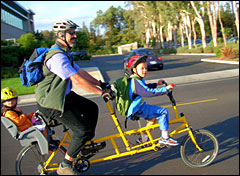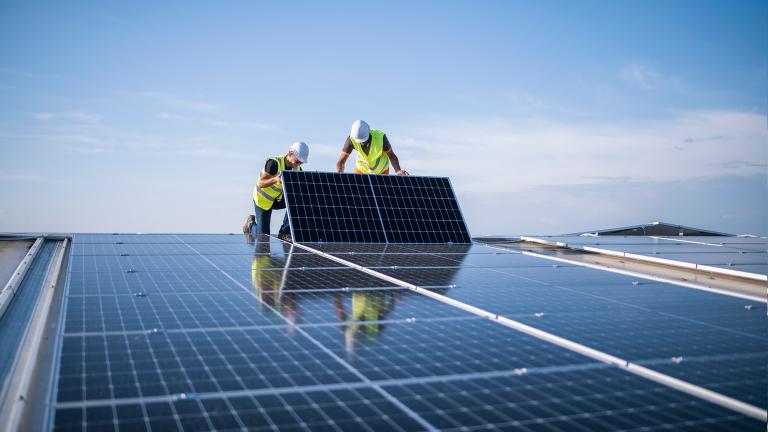Umbra,
Your columns have opened up a whole new world on transport by bike. I don’t have a question but am considering purchasing our second Xtracycle for our family. I can carry our toddler and all our groceries, or another adult, or a cooler full of beer on one side and camping gear on the other — all by bike. Not to say I don’t “have to” drive from time to time, but it keeps me out of the car about four to five days a week.
Keep up the awesome work.
JP
Athens, Ga.
Dearest JP,
You keep up the awesome work, too. Biking is the greatest. I was just getting the skinny from a Biking Dad who has hauled his two kids by bike for most of their childhoods; he said his main motivation was joy. I suppose cars can bring joy, too — the only car that brings me joy remotely approaching biking joy, though, is an MG TD convertible. I spend most of that ride wondering when we’re going to die, and I certainly can’t bring my kid along.
By now you’ve hopefully all read my columns about cargo bikes and various nice saddlebags and panniers (JP also suggests this saddlebag source), and almost gotten sick of hearing me talk about bicycling. You must see that in honor of this week’s summer-parenting theme we need to review ways to bike with kids. Not older kids who can bike on their own; they, after all, get their own bike, and adults can suss out each particular kid’s skills and capabilities. I’m talking about younger children who need to be hauled — precious cargo such as JP’s toddler.
Whether we bike with our kids on short bike-path rides with a picnic destination, or we bike them to preschool, or we use a bike for errands, grocery shopping, visiting friends, or going to the beach, kids will love it. We get exercise, they learn biking habits, no emissions or particulate matter are produced, and other folks are inspired to follow suit.
Young children who aren’t able to bike on their own need to be seated on their own mini-seat, or towed behind the bike. Seats on the bike are for smaller children over the age of one and below the weight limit of the bike seat (usually 40 pounds). Small kids can also sit in a tow-behind closed trailer, while older kids can ride tandem-style. A surprising range of these kid-bike accessories exists, but we don’t know much about their relative safety; there is no readily available data-heavy comparison, though there are plenty of parental opinions out there. My completely personal two cents is that you should use the child bike seat that you prefer, based on your own skills, bike habits, and confidence level.
The safety aspect that you can control is to obsessively follow all bike safety precautions. Be sure to ride very defensively. Tune up your bike before starting the biking season; wear newish, well-fitted helmets that have never been in accidents, and read and follow the instructions for adjusting straps. Keep three feet away from parked cars to avoid collisions with opening doors, a common cause of accidents. Assume cars do not see you. Wear loud clothes and use hand signals and horns. If you are a novice, gain confidence and learn basic bike safety skills before taking a child for a ride in any apparatus. I loved these tips for traffic riding from Bicycle Safe; also the basic rules from the National Highway Traffic Safety Administration. Some of the child biking accidents I read about involve human error at a near-standstill, such as the bike falling over as the adult dismounts, or a trailer flipping on its way over a curb. Be aware of these potential problems as well.
With your safety skills ingrained, it’s time to find a child bike apparatus and get started. Child bike seats fit either behind the adult’s seat or behind the handlebars. There are several designs that fit between the handlebars and the rider. A few appear to have poor clearance for the rider’s knees; others, such as the ibert, seem to have resolved this problem. The rear-mounted seats snap onto a rack or mount on a post attached to the rider’s seat post area. Dearest JP has an Xtracycle, and may also have the company’s Peapod bike seat, which carries a heavier child than most and mounts on a post. With the Peapod and Xtracycle, JP could even go the further step of putting a toddler in the seat, and having a five-year-old ride on the extended rack. I’ve seen pictures. It’s more costly than a plain old bike, less costly than a car — obviously unnecessary for the occasional ride, but central to the urban low-car family.
Tow-behind bike trailers hitch to the rear of your bike. The child rides at street level in a little chariot filled with whatever toys and food are deemed necessary during the ride. People like trailers because ideally they won’t tip if the cyclist falls. They do provide a lot of resistance and are heavy to haul, according to my chat with Biking Dad. Both the mounted seats and the trailers are for smaller kids who are not able to ride their own bike.
For kids able to do a little biking, you can get a tandem extension. The Trail-a-Bike is one such extension; it’s basically the back half of a small bicycle, which attaches to your bike via a long stem (other brands exist). Biking Dad rode his kids to school on a Trail-a-Bike for several years, up and down one of the daunting Seattle hills. If you have an actual tandem bicycle, you could put a kid on the back seat by purchasing a “child stoker” kit to raise the chain ring and pedals. Then you could stick a Trail-a-Bike on the back of the tandem and tow two kids around town, with a little help from them on the hills!
Phew! Much to say about biking with kids. No matter which way or how often you do it, biking all gets back to where we started: joy.
Blissfully,
Umbra



